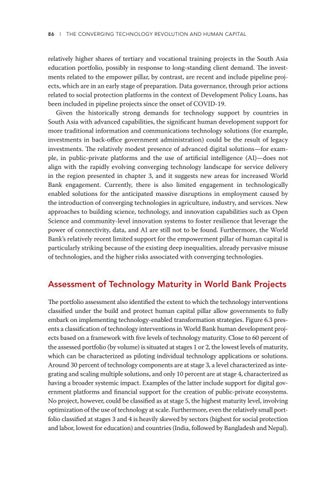86 l THE CONVERGING TECHNOLOGY REVOLUTION AND HUMAN CAPITAL
relatively higher shares of tertiary and vocational training projects in the South Asia education portfolio, possibly in response to long-standing client demand. The investments related to the empower pillar, by contrast, are recent and include pipeline projects, which are in an early stage of preparation. Data governance, through prior actions related to social protection platforms in the context of Development Policy Loans, has been included in pipeline projects since the onset of COVID-19. Given the historically strong demands for technology support by countries in South Asia with advanced capabilities, the significant human development support for more traditional information and communications technology solutions (for example, investments in back-office government administration) could be the result of legacy investments. The relatively modest presence of advanced digital solutions—for example, in public-private platforms and the use of artificial intelligence (AI)—does not align with the rapidly evolving converging technology landscape for service delivery in the region presented in chapter 3, and it suggests new areas for increased World Bank engagement. Currently, there is also limited engagement in technologically enabled solutions for the anticipated massive disruptions in employment caused by the introduction of converging technologies in agriculture, industry, and services. New approaches to building science, technology, and innovation capabilities such as Open Science and community-level innovation systems to foster resilience that leverage the power of connectivity, data, and AI are still not to be found. Furthermore, the World Bank’s relatively recent limited support for the empowerment pillar of human capital is particularly striking because of the existing deep inequalities, already pervasive misuse of technologies, and the higher risks associated with converging technologies.
Assessment of Technology Maturity in World Bank Projects The portfolio assessment also identified the extent to which the technology interventions classified under the build and protect human capital pillar allow governments to fully embark on implementing technology-enabled transformation strategies. Figure 6.3 presents a classification of technology interventions in World Bank human development projects based on a framework with five levels of technology maturity. Close to 60 percent of the assessed portfolio (by volume) is situated at stages 1 or 2, the lowest levels of maturity, which can be characterized as piloting individual technology applications or solutions. Around 30 percent of technology components are at stage 3, a level characterized as integrating and scaling multiple solutions, and only 10 percent are at stage 4, characterized as having a broader systemic impact. Examples of the latter include support for digital government platforms and financial support for the creation of public-private ecosystems. No project, however, could be classified as at stage 5, the highest maturity level, involving optimization of the use of technology at scale. Furthermore, even the relatively small portfolio classified at stages 3 and 4 is heavily skewed by sectors (highest for social protection and labor, lowest for education) and countries (India, followed by Bangladesh and Nepal).

